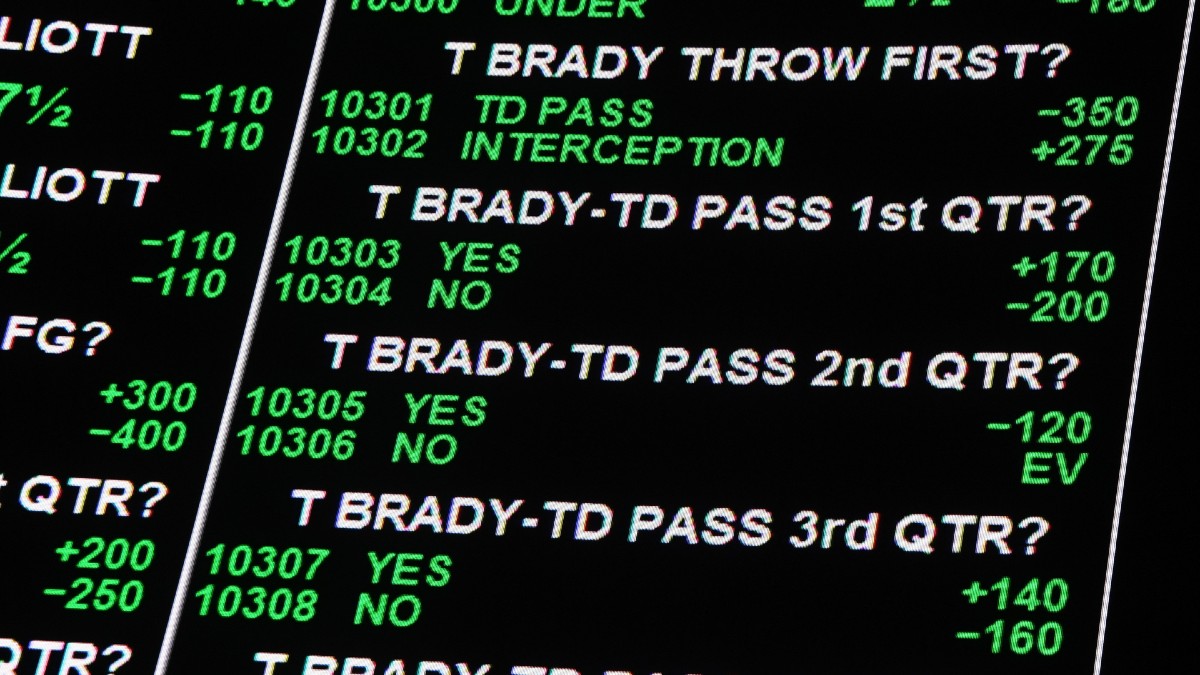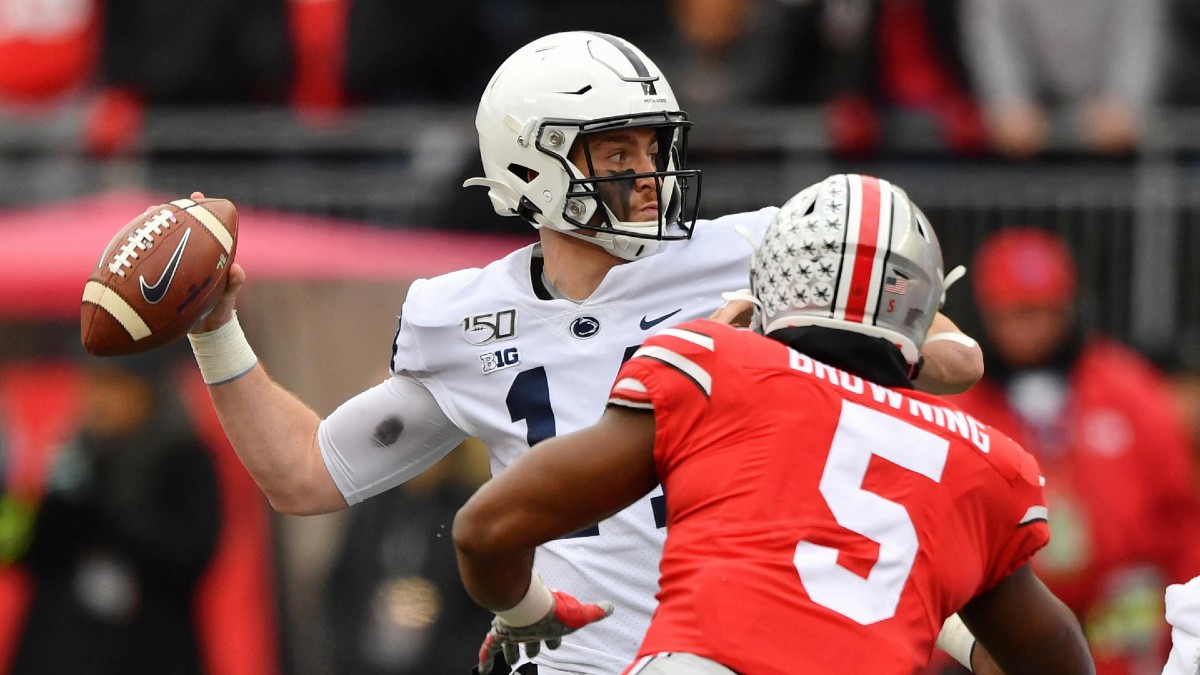
Ethan Miller/Getty Images. Pictured: Westgate SuperBook
| Table of Contents | |
| 1. How to Read American Odds | |
| 2. American Odds in Spreads vs. Moneylines | |
| 3. Why You’re Risking More | |
| 4. How to Calculate Payouts | |
That little -110 next to your desired bet at a sportsbook? It might be old hat to experienced sports bettors in the U.S., but it’s not what most see around the world, and it probably won’t make sense to most new bettors.
That’s because this format is called American odds, and it’s only used in the U.S.
American odds are less intuitive than decimal odds, but they’re the default option at any U.S. sportsbook.
Here’s how to read American odds if you’re new to sports betting.
_BookPromo=49
How to Read American Odds
American odds are centered around winning or wagering $100 on a given bet.
If You’re Betting a Favorite: The odds for favorites will have a minus (-) sign in front, and indicate the money you need to risk to win $100.
So if you’re betting on the Yankees at -130, you need to risk $130 and will win $100 if New York wins the game (plus your original $130 back).
If You’re Betting an Underdog: The odds for underdogs will have a plus (+) sign in front, and indicate the money you’ll win for every $100 risked.
So if you’re betting the Red Sox at +110, you’ll risk $100 and will win $110 if Boston wins the game (plus your original $100 back).
Of course, you don’t always want to bet $100. American odds can scale up or down based on your bet size.
It might be easier to think in terms of dollars instead of $100’s. So for every $1.30 risked on the Yankees in this game, you’d win $1. For every $1 risked on the Red Sox, you’d win $1.10.
If you want in on the baseball action, here are a few resources to help you bet with skill:
- How to Bet on Baseball Guide
- Bet with MLB Sharps and check out our MLB Picks
- Go with or against the crowd using our Public Betting insights
| » Return to the table of contents « |
American Odds in Spreads vs. Moneylines
When you’re trying to bet on sports, you’ll see American odds everywhere.
But there are two different ways they’re used:
- On their own, like for a moneyline (which just requires you to pick the winner of the game).
- With a point spread or other line, like an over/under. The team you bet still needs to cover the spread, but the American odds indicate how much you need to risk for that bet.
Let’s use Penn State vs. Ohio State in college football as an example, with odds from DraftKings.
American odds on their own

Ohio State is the perceived stronger team in this game, so the Buckeyes are the favorite at DraftKings. Based on these odds, Ohio State is expected to win about 70% of the time.
To bet Ohio State -250 to win, you’ll have to risk $2.5 for every $1 you want to win. Remember, OSU just needs to win the game.
At +200, a winning bet on Penn State will pay you $2 for every $1 risked.
Since the moneyline just requires you to pick a winner, we only need the odds. We don’t need a point spread or line of any kind.
American odds next to a point spread or over/under

The second way American odds are used is next to a corresponding line, like a point spread or over/under.
The odds dictate how much you have to risk, but not what needs to happen for you to win the bet.
You only have to risk $1.10 for every $1 you want to win when betting Ohio State -6.5, but it has to win the game by at least 7 points.
Same goes for Penn State +6.5 — you’re only risking $1.10 for every $1 you want to win. If the Nittany Lions lose by 1-6 points or win the game, you win your bet.
Most of the time, football and basketball spreads will be -110 — just a 10% tax on your bet — since the spread makes things equal.
For lower-scoring sports, the point spreads will be low (often -1.5) but the odds on each side will be different, because it’s harder for a baseball, soccer or hockey team to win by multiple goals.
For example, you could get paid +150 betting Yankees -1.5 against the Red Sox, and have to risk -200 for Red Sox +1.5 in that same game.
| » Return to the table of contents « |
Why Do I Have to Risk More on The Favorite Than I’ll Win on the Underdog?
Risking $2.5 for every $1 you want to win on Ohio State seems unfair when you’d only get paid $2 for every $1 you want to risk on Penn State.
This gap in odds is what’s called juice or vigorish — it’s essentially the tax a sportsbook charges for taking your action.
Over thousands of bets, this tax adds up and makes it difficult for most bettors to become profitable.
If you want to bet smartly on college football, here are a few of our recommended resources:
- College Football Betting Tips for Profitability
- College Football Betting Tips on Fading the Public
- Check out our expert team with College Football Picks and real-time College Football Odds
| » Return to the table of contents « |
How To Calculate My Bet With American Odds
Over time, figuring out how much -120 returns when you risk $60 (it’s $50) will become second nature. And sportsbooks from PointsBet to William Hill always calculate your bets automatically. You can also use our odds converter.
But if you want to figure out your bet amounts on your own, here is the simple math.
The basic formulas vary slightly depending on if you’re betting a favorite or an underdog.
There are two ways to calculate each, based on either how much you want to wager or how much you want to win.
Favorite Method No. 1: The first method is calculating how much you want to win.
Let’s say you want to win $25 betting on the Yankees at -130 — you’re willing to risk a little more money to get the $25.
Enter $25 as the win amount and -130 as the moneyline into the following formula. You’ll arrive at $32.50, meaning you need to risk that much to win $25.
Win Amount * ((-1 * Moneyline) / 100)
$25 * (130/100) = $32.50
Favorite Method No. 2: The second method is calculating how much you will win if you wager a certain amount. Let’s say you’re only comfortable wagering $25 on the Yankees at -130, knowing you’ll profit a little less if they win.
Enter $25 as the win amount and -130 as the moneyline into the following formula. You’ll arrive at $19.23.
Wager Amount * ((100/(Moneyline * -1))
$25 * (100 / (-130 * -1)) = $19.23
Underdog Method No. 1: There are similarly two options for underdogs. The first is calculating how much you want to win based on a set bet amount.
Let’s say you want to bet $40 on Tony Ferguson. Enter $40 and +230 into the following formula.
Wager * (Moneyline / 100)
$40 x (230 / 100) = $92
Underdog Method No. 2: The second option is calculating how much you need to bet to win a certain amount.
If you want to win $100 on Ferguson when his moneyline is +230, you would do the following and arrive at a $43.48 bet:
Win Amount / (Moneyline / 100)
$100 / (230 / 100) = $43.48
| » Return to the table of contents « |
